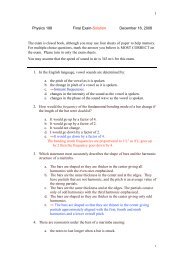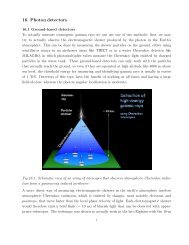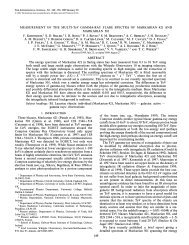Chapter 28 Quantum Mechanics of Atoms
Chapter 28 Quantum Mechanics of Atoms
Chapter 28 Quantum Mechanics of Atoms
You also want an ePaper? Increase the reach of your titles
YUMPU automatically turns print PDFs into web optimized ePapers that Google loves.
<strong>28</strong>.10 Fluorescence and Phosphorescence<br />
Fluorescence occurs when the absorbed<br />
photon is ultraviolet and the emitted photons<br />
are in the visible range.<br />
Phosphorescence occurs when the electron is<br />
excited to a metastable state; it can take<br />
seconds or more to return to the lower state.<br />
Meanwhile, the material glows.<br />
<strong>28</strong>.11 Lasers<br />
A laser produces a narrow, intense beam <strong>of</strong><br />
coherent light. This coherence means that, at<br />
a given cross section, all parts <strong>of</strong> the beam<br />
have the same phase.<br />
The top figure shows absorption <strong>of</strong><br />
a photon. The bottom picture shows<br />
stimulated emission – if the atom is<br />
already in the excited state, the<br />
presence <strong>of</strong> another photon <strong>of</strong> the<br />
same frequency can stimulate the<br />
atom to make the transition to the<br />
lower state sooner. These photons<br />
are in phase.<br />
<strong>28</strong>.11 Lasers<br />
To obtain coherent light from stimulated<br />
emission, two conditions must be met:<br />
1. Most <strong>of</strong> the atoms must be in the excited<br />
state; this is called an inverted population.<br />
<strong>28</strong>.11 Lasers<br />
2. The higher state must be metastable,<br />
meaning that the probability <strong>of</strong> spontaneous<br />
decay is small. This means that transitions<br />
occur through stimulated emission rather than<br />
spontaneously.<br />
<strong>28</strong>.11 Lasers<br />
The laser beam is narrow, only spreading due<br />
to diffraction, which is determined by the size<br />
<strong>of</strong> the end mirror.<br />
<strong>28</strong>.11 Lasers<br />
A metastable state can also be created through<br />
interactions between two sets <strong>of</strong> atoms, such as<br />
in a helium-neon laser.<br />
An inverted population<br />
can be created by<br />
exciting electrons to a<br />
state from which they<br />
decay to a metastable<br />
state. This is called<br />
optical pumping.<br />
7







